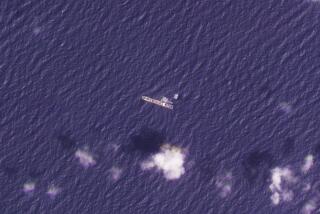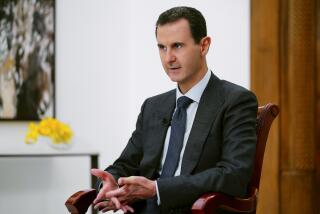Baghdad Airport Still in a Holding Pattern
- Share via
BAGHDAD — Don’t look for a Starbucks, a Disney Store or Burger King at the 20-year-old, French-built terminal that still bears the words “Saddam International Airport.” And don’t bother calling a travel agent anytime soon.
Hoping to reconnect this long-isolated nation to the outside world, U.S. military and business forces are working around the clock to reopen the airport for commercial use. Air Force engineering teams are toiling in 110-degree heat to fill 10 bomb craters on the main runways -- the calling cards of allied forces trying to cut off a potential escape route for Saddam Hussein and his inner circle.
David Jones, the senior U.S. advisor to what’s left of Iraq’s Civil Aviation Authority, said over the weekend that he hopes to reopen Baghdad International to commercial traffic “as quickly as possible” for reasons both financial and symbolic.
“It’s important for Iraq to see that commerce is coming in,” he said, “and to see that Iraq is getting back to normal.”
The stalled airport reconstruction project illustrates how few immediate benefits Iraqis and their economy are getting from what is expected to become billions of dollars that U.S. taxpayers will spend to rebuild the country.
The work has been delayed by continuing violence and insecurity, principally in Baghdad. Seven prime U.S. contractors hired by the U.S. Agency for International Development to manage Iraq’s reconstruction are just beginning to trickle into a capital city that top U.S. commanders say still isn’t safe.
For example, Washington-based SkyLink Air & Logistical Support, which won an 18-month USAID contract worth millions this month to bring the airport up to international standards and perhaps manage it for as long as two years or even more, has only a handful of engineers here. They are just completing an initial assessment of what’s needed to make the airport safe for civilians.
But in the case of Baghdad International, Jones said during a recent airport tour, lawyers also are to blame.
The ultimate challenge, he said, is getting all the equipment in place at the long-neglected and underused facility to satisfy International Civil Aviation Organization safety standards, which would relieve the U.S. military occupiers of legal liability in the event of an accident.
Jones cited the April 3, 1996, crash of a U.S. Air Force Boeing 737, which slammed into a mountainside, killing Commerce Secretary Ron Brown and 34 others on board, as it approached the Dubrovnik Airport in postwar Croatia. The accident, caused in part by uncertified navigational aids and other landing equipment at the U.S.-controlled airport, triggered a blizzard of lawsuits against the U.S. government filed on behalf of the trade mission members on board.
An Air Force investigation into the crash, which filled 17,000 pages and 22 volumes, raised the safety bar for allowing commercial air traffic in such situations.
For now, Jones said, the only aircraft permitted to land here are those of humanitarian aid organizations, the U.S. military, its allies and its hired private contractors, which include DHL.
DHL has started overnight-air service into Baghdad. On Sunday, the first commercial airliner touched down, a Kuwait Airways Airbus 310 packed with 10 tons of humanitarian supplies and airline officials hoping to land at the ground floor of Iraq’s commercial aviation industry.
U.S. Air Force Col. Ron Watkins, who is managing the airport, said there is just one operational runway, and yet six to 10 flights, on average, are landing each day.
“The limitation is not here in Baghdad,” he said. “It’s the coordination process -- and safety factors.”
Bringing the airport up to those international safety standards “is a monumental task,” Watkins added. “It’s been attacked. It’s been through a war.”
He quickly added that well- focused targeting by allied air assaults spared the terminal, the control tower and other airport buildings but that the war knocked out power, plumbing, sewer and water systems throughout Baghdad and its main airport. “Those are the hard things,” he said.
Lt. John Welsh, a 37-year-old U.S. Army civil affairs reservist from Connecticut, has been the point man working to restore those basic services at the airport. Welsh, an engineer for aviation giant Pratt & Whitney Corp., has been working the neighborhoods near the airport to ferret out former Iraqi airport employees, put them to work on rigging temporary repairs and pay them out of petty cash.
Hiring the maximum number of Iraqis, though, is a knotty task. Security rules require that Welsh provide one U.S. military escort for every four Iraqis, and ground forces here already are spread thin. So Welsh has been doing some of the jerry-rigging himself at an airport that was crippled by 12 years of international sanctions and is largely patched together with cannibalized parts and Iraqi ingenuity.
In the control tower, Mohammed Auda, a senior official of the former regime’s civil aviation department who is working alongside Americans as the airport’s Iraqi director, said air-traffic control equipment, radar and guidance systems installed by the French company that built the airport are working.
But there is an acute shortage of spare parts.
“They didn’t give us anything during the sanctions,” Auda said of the French firm. “Just words. They didn’t cooperate at all.”
Instead, the U.S. military has installed its own mobile radars, navigation and landing systems. And a team of Australian Royal Air Force air-traffic controllers is manning the tower.
On the ground, engineers from U.S. company SkyLink are finishing their assessment of the airport’s needs. They completed one for the airport in the southern city of Basra this month, and they soon will begin a similar airport study in the northern city of Mosul.
Mike Douglas, the company’s liaison in Baghdad, declined to comment on the extent of needed repairs until the reports are completed by month’s end.
“The airports are very well designed,” Douglas said, noting that the model for Baghdad International was Charles de Gaulle airport outside Paris. “They were built to a very high standard, but they have not been used very much for a very long time.”
As for the prospect of subcontract work for French companies, whose government officially opposed the U.S.-led invasion and occupation of Iraq, Douglas slammed the door. “I don’t think we see a need for their involvement in the future,” he said.
Skylink’s contract calls for the company to manage the airport “only on an emergency basis -- for an unspecified period of time.” Ultimately, the company must hand the airport over to the Iraqis, and SkyLink is required to plan and manage a “transition from contractor management back to national or local management.”
Meanwhile, the only major revenue that the airport is likely to generate for Iraq is overflight fees -- the money airlines pay to a country each time their aircraft fly over it en route to somewhere else.
Those fees are potentially lucrative, and Iraq has been denied them because much of the country was under U.S.- and British-enforced “no-fly” zones for more than a decade.
“I see them generating quite a lot of money just in overflight fees,” advisor Jones said. “That will generate the funds needed to bring the rest of the airport back up.”
But again citing uncertified guidance systems on the ground, Jones added: “Civilian overflights will probably happen in a few months’ time.”
More to Read
Sign up for Essential California
The most important California stories and recommendations in your inbox every morning.
You may occasionally receive promotional content from the Los Angeles Times.













